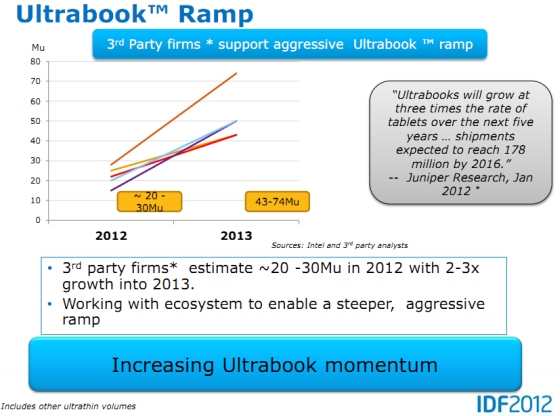An ultrabook is a thin and light laptop with an Intel processor… and some other stuff. It’s kind of tough to define an ultrabook, because Intel has a habit of using aspirational language to describe the category rather than offering an actual list of specs.

What is clear is that Intel sees thin and light laptops as the future, and the company is spending hundreds of millions of dollars to develop the platform, work with PC makers, and market ultrabooks. Less than a year after the category was introduced there are over a dozen ultrabooks on the market, and Intel expects to see 75 more this year.

Those won’t all look like the Asus Zenbook UX31 or Acer Aspire S3. We’ve already started to see ultrabooks with larger screens and optical disc drives. In the next year or two we should also start to see models with touchscreens, sensors, and removable tablet portions.
The first big changes are expected in the coming months when Intel’s 3rd generation Core processor family (Ivy Bridge) hits the streets, offering better graphics and lower power consumption. Then later this year Microsoft will release Windows 8, an operating system designed at least as much for touchscreen input as for keyboard and mouse input.
Those two updates could lead to a new class of ultrabooks that look very different from the models available for purchase today.
Intel does offer some guidelines for what makes an ultrabook an ultrabook. It has to measure less than 21 millimeters thick, get 5 hours of more of battery life, and resume from sleep in less than 7 seconds, for instance.

In order to do that, Intel is working to standardize thinner battery sizes, develop new case design technologies, and offer other assistance to laptop makers.
The company’s goal is to get to a point where ultrabooks change the way we think about portable computers altogether. Early on Intel set a goal of changing the notebook industry so that 40 percent of laptops sold would be ultrabooks.
In order for that to happen, prices will probably have to fall at the same time as companies are pushing new designs, but since the word “ultrabook” is so hard to define that Intel resorts to catch phrases such as “it is an expression of me,” it’s hard to say that ultrabooks won’t be the new face of notebooks in a few years.





What’s with the screen size pie chart? 5 slices, with one unlabelled slice. Is that for ultrabooks without screens?
Since the only definitions of what ultrabook means revolve around minimum battery life, resume from sleep times, and maximum thicknesses other than being at least ‘Security Ready’… yeah the term is meaningless outside of getting free hand outs from Intel to help market the ‘category’ which was a neat loophole for Intel to bribe OEMs to not use AMD processors in the settlement the 2 companies signed.
Other than that little conspiracy theory, I don’t see much this new ‘category’ brings to the table. I was excited at first, but now I’m just beyond ‘meh’. The thin form factor pretty much precludes a graphics card, and 2nd Gen Core processors are nothing to write home about GPU wise (other than how much better they were than anything from Intel before them, which is a comment on trusting Intel to deliver quality graphics more than it is about how good Sandybridges GPU is).
Basically my beef is that right now there are too many trade offs in the form factor. You give up any hope of a user replaceable battery, you put massive thermal constraints on the hardware to the point where typically it can only turbo the CPU OR the GPU, not both…
You’re being asked to pay a lot more for a marketing term.
Worse the ballpark the current ultrabooks are playing in is right next to the MacBook Air, and so far I have yet to see an ultrabook that comes close to it as far as performance and battery times go…
So good on Intel for starting the ultrabook ‘revolution’. I’m just not sure what the point is.
Other than trying to make sure AMD can’t compete in the space because Intel owns the marketing name that is. That makes all the sense in the world I guess.
“The thin form factor pretty much precludes a graphics card”
Not entirely, there are Ultrabooks coming with discrete graphic cards.
The core problem many people are having is they expect pretty much immediate gratification but the Ultrabook segment has always been a long term plan for Intel.
While Ultrabook may be little more than a marketing scheme now but the overall idea is to re-invent the laptop market and push for changes that when they all finally are done would actually advance the PC market and bring about a re-vitalizing to an otherwise aging industry.
All of which will just take time to accomplish and Intel knows they have to be in it for the long haul to get there.
So basically wait for 3rd and 4th gen Ultrabooks, when Intel releases their 22nm Haswell and we get other next gen technology like more energy efficient screens, more standardized manufacturing standards, etc. Before we really see their plan start to come together and produce real change.
AMD on its side has its own plans for the Ultrabook market but they also have their own problems getting there. Like the same issues with 28nm manufacturing effecting the ARM market also effects them. They even had to cancel some planned chips because they would not be ready on time and decided it would be more efficient to focus on their next gen for next year and not so much for this year.
So next year is when we’ll really see what both companies will have to offer.